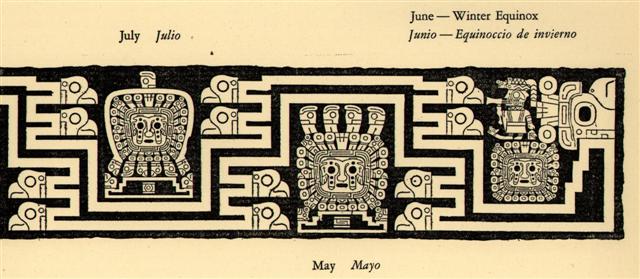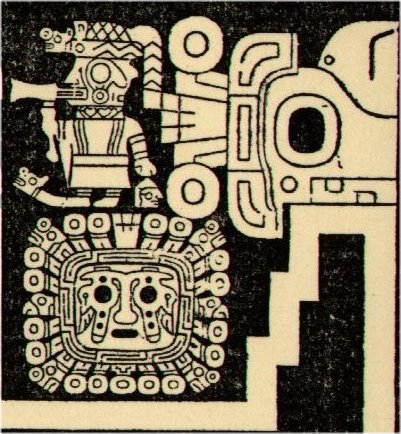3. Very early in my work with the rongorongo texts I was puzzled by why Sun appeared to be 'decapitated' in the middle of summer, when his path turned around, e.g. as I imagined it described in Gb1-6--7:
Later I came to recognize that 1-6 and 1-7 probably are alluding to 16 followed by 17 as indicators for where one sequence of glyphs is terminating and the next beginning. Another such example is the length of the G text, 16 * 29Ĺ = 472 glyphs, and 236 = 472 / 2. By keeping this mystery in mind I was open for inputs which could present clues and in The White Goddess (a name for Moon) several such are dispersed, for instance the myth about Hercules - who according to Graves had his roots somewhere in the region of the Atlas Mountains as the god Schu - by way of which it became rather clear that Spring Sun was doomed to die at midsummer (cfr at Kai Viri): ... Hercules first appears in legend as a pastoral sacred king and, perhaps because shepherds welcome the birth of twin lambs, is a twin himself. His characteristics and history can be deduced from a mass of legends, folk-customs and megalithic monuments. He is the rain-maker of his tribe and a sort of human thunder-storm. Legends connect him with Libya and the Atlas Mountains; he may well have originated thereabouts in Palaeolithic times. The priests of Egyptian Thebes, who called him Shu, dated his origin as '17,000 years before the reign of King Amasis' ... ... Midsummer is the flowering season of the oak, which is the tree of endurance and triumph, and like the ash is said to 'court the lightning flash'. Its roots are believed to extend as deep underground as its branches rise in the air - Virgil mentions this - which makes it emblematic of a god whose law runs both in Heaven and in the Underworld ... The month, which takes its name from Juppiter the oak-god, begins on June 10th and ends of July 7th. Midway comes St. John's Day, June 24th, the day on which the oak-king was sacrificially burned alive. The Celtic year was divided into two halves with the second half beginning in July, apparently after a seven-day wake, or funeral feast, in the oak-king's honour ... ... The manner of his death can be reconstructed from a variety of legends, folk-customs and other religious survivals. At mid-summer, at the end of a half-year reign, Hercules is made drunk with mead and led into the middle of a circle of twelve stones arranged around an oak, in front of which stands an altar-stone; the oak has been lopped until it is T-shaped. He is bound to it with willow thongs in the 'five-fold bond' which joins wrists, neck, and ankles together, beaten by his comrades till he faints, then flayed, blinded, castrated, impaled with a mistletoe stake, and finally hacked into joints on the altar-stone. His blood is caught in a basin and used for sprinkling the whole tribe to make them vigorous and fruitful. The joints are roasted at twin fires of oak-loppings, kindled with sacred fire preserved from a lightning-blasted oak or made by twirling an alder- or cornel-wood fire-drill in an oak log. The trunk is then uprooted and split into faggots which are added to the flames. The twelve merry-men rush in a wild figure-of-eight dance around the fires, singing ecstatically and tearing at the flesh with their teeth. The bloody remains are burnt in the fire, all except the genitals and the head. These are put into an alder-wood boat and floated down the river to an islet; though the head is sometimes cured with smoke and preserved for oracular use. His tanist succeeds him and reigns for the remainder of the year, when he is sacrificially killed by a new Hercules ... Later I realized how the flow of ebb and flood could be the structure which was at the bottom of the idea of a double-cycle (cfr at Fishing Up Land). Twice a day the flood covers the exposed sea-bed preventing people from gathering nourishing tidbits. No light can penetrate into deep water. Thus we can correlate some basic features of reality, for instance:
Rehua has 2 wives (cfr at Ruhi): ... The 2 wives of Rehua probably represent his 2 'lands' ... Ruhi-te-rangi can be translated as 'the languor of summer in the sky', while Whaka-onge-kai is 'she who makes food scarce' ...
With the seasons of the sky roof in mind instead of our seasons down on earth we can now recognize the meaning of 'summer in the sky' - it should refer to the time when Leo rules (once probably much longer than a month). Therefore rongorongo signs which can be identified, as for instance the hand gesture which looks like a picture of eating, will carry additional implications. For us civilized people these are at first not noticed. For instance carries the sign for eating (kai) not only implications of a flourishing life resulting in growth but also such additional implications as derive from the first ones. Where there is kai it cannot be winter. Where there is kai the resulting growth in strength and stature will be like the behaviour of Sun in spring or during a.m.:
The eating Sun juvenile grows to full and stable size (tagata) at noon or midsummer, then comes his initiation and encounter with Venus and the origin of a new cycle. What did the juvenile Sun eat? This new puzzle was solved by OgotemmÍli: 'The rays drink up the little waters of the earth, the shallow pools, making them rise, and then descend again in rain.' Then, leaving aside the question of water, he summed up his argument: 'To draw up and then return what one had drawn - that is the life of the world.' In other words, when Sun returns what he has 'eaten' - during autumn or p.m. - there will be rain (as when after drinking much you have to urinate). When there is much rain the sky is covered by the clouds and Sun is no longer visible. When Sun no longer is visible (present) he must be somewhere else. If the rain arrives abruptly, then he cannot have moved very far. Perhaps he has hid himself down in a cave (like the Rain God). Flood comes twice a day and the theory of correspondences suggests Sun will hide himself twice. If he is absent it is as if he was dead and the time just after the solstices could be the proper places for him to be buried. The Polynesians knew Sun was creating summer north of the equator when there was winter south of the equator and that Sun moved from one hemisphere to the other around the equinoxes when his speed was at a maximum. At the solstices something else happened, his speed slowed down to a standstill and as a result his dead old head had to come off. In the Gateway of the Sun, at Ti(a)huanaco, this message is delivered by a figure blowing his horn. He carries the old head dangling from his left hand and at the other end of the sequence of months (at the other solstice) another such figure stands, also carrying a head:
The 'vertical' movement of Sun across the equator is similar to but radically different from how ebb and flood moves in time with Moon - the tides flow across the longitudes (time) instead of the latitudes of the 'climber'. And her face illustrates the changes from black new Moon ('flood') to white full Moon ('ebb') and back again, while the face of Sun stays the same. Once upon a time Virgo probably represented Mother Earth (or the Summer Maid in the sky), and in the Babylonian zodiac she was divided, a sign which is congruent with how summer is divided by the solstice or the day divided by noon:
Furrow, the lower and later of the pair, should represent the 'cave' or burial place for Sun. The Virgin here became like a 'coffin' where Old Sun would be buried and from which miraculously a new Sun later would be born. At The Mad Hatter I have tried to explain what role Mercury has in this grand old story and why he has no shoes. In the picture below we can see that his right foot is exactly below the corner (i.e. midsummer) and also that he is rushing into his own shadow. The tiny figure is blinded by the much too big hat which probably was just perfect for its previous owner:
|







